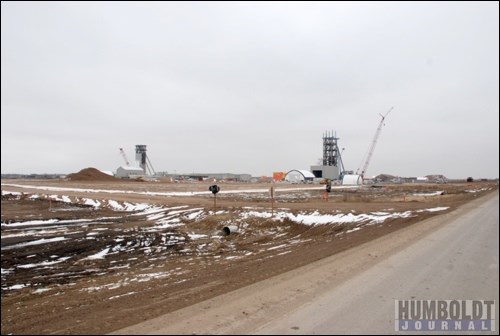It is a huge project which stands to benefit the entire region.
Work on the BHP Billiton Jansen mine is continuing despite rumours that the mine will not open.
Although the BHP Billiton board of directors has not given final approval of the mine, construction is continuing.
Tim Cutt, president of Diamond and Special Products, said he is proud of how far the mine has come already during a media tour of the mine on October 29.
In 2009, the land where the mine is being constructed was an open field with a stake marking where the mine would be built one day.
Since then, the site has radically changed. Instead of a wheat field, there are now a couple of mine shafts, site buildings and on-site housing for mine workers.
Last week, BHP Billiton installed the shaft boring roadheader so they can begin the excavation stage of the mine.
"To actually have the freeze collars, the sinking headframes, the winch houses and starting to connect the (shaft boring roadheader) is very exciting," said Cutt. "We think by the end of 2015 we should be in the ore body and starting to build production rooms."
Although many analysts believe BHP Billiton should cut their losses and not continue developing the Jansen mine, Cutt disagrees.
"We fundamentally believe in the basic fundamentals of potash and the long term viability of potash," Cutt explained. "It's our job to build a mine that's going to be low on the cost-curve and very competitive."
Cutt said potash demand has been increased by three per cent per year since the 1990s. With the population of the world going up and more people wanting to eat healthy, he expects the demand to continue to increase.
"We believe there is room for new entrants into the potash market," said Cutt.
The company has committed about $2 billion to Saskatchewan potash.
"We have spent about $1 billion on acreage and about $1 billion to get to the point you see today," said Cutt.
The mine has not received final approval, but Cutt hopes it will by the summer of 2013.
"We talk to the board on a regular basis," said Cutt. "They understand what is going on here and get pictures on a regular basis. They are enthusiastic."
Although above ground the mine doesn't cover too much space, it will have a huge underground footprint, stretching 18 to 20 kilometres east to west and about 30 kilometres north to south. It will produce up to eight million tonnes each year once operational.
In the construction stage, the mine will employ 2,500 workers needed to construct the mine but 1,000 workers will be needed to run the mine when it is operational.
"There is a huge opportunity for local communities," said Cutt.
He explained once the mine is operational, instead of having the workers stay in Discovery Lodge, a camp being built for workers to stay in during the construction stage of the mine, they want their employees to live in the local communities.
"We have been working with local mayors and councillors," said Cutt about the anticipated population influx. "There is a huge opportunity for (these communities). We have to do it right."
The communities are trying to plan for growth.
"A lot of what we are doing as communities throughout the region here is trying to plan for growth that is five, 10, 15 and 20 years away," said Malcolm Eaton, mayor of Humboldt during a luncheon with community leaders at the Jansen site. "I think just planning for the growth has been a challenge."
BHP has predicted Humboldt's population will double within 10 years.
During the construction stage, the workers will live in Discovery Lodge, an on-site work camp.
The lodge will have rooms with private bathrooms, a full gymnasium, rec rooms, laundry facilities, a kitchen, skating rink and theatre. The first 500 rooms are expected to be ready by December.
BHP is also working closely with the First Nations communities, getting them involved with the mine as well.
Cutt is excited to see the project moving forward.
"Over the last year we have closed down our Vancouver office and we've moved our headquarters to Saskatoon," said Cutt.
Once operational, the Jansen mine will be the largest potash mine in the world.




